Putting it All Together: Enhance Your Stand-Up Skills by Blending Your Striking with Takedowns
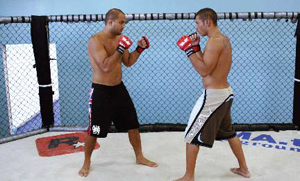
B.J. ‘the prodigy’ Penn is highly regarded by many to be pound-for-pound the best mixed martial artist in the world. After earning his black belt in just four years and dominating Brazilian jiu-jitsu competition, he entered mixed martial arts and took the real fighting world by storm. Penn is currently coaching the next season of the UFC’s “Tough Enough” reality show on Spike T.V. In his new book Mixed Martial Arts: The Book of Knowledge, Penn shares the philosophy and intricate techniques that have allowed him to defeat UFC champions such as Matt Hughes. It is the first and only book that lays out a complete and comprehensive mixed martial arts system. The following two techniques are taken from the first section of his book, which focuses on striking to the takedown.
This is an excerpt from Mixed Martial Arts: The Book of Knowledge by B.J. Penn, Glen Cordoza, and Erich Krauss. Victory Belt is the publisher. For more information about the book, see www.victorybelt.com.
Striking to the Takedown
Meshing strikes with takedowns is a fundamental component of MMA that far too many fighters neglect. I especially notice this with wrestlers and jiu-jitsu practitioners. The striking aspect of the sport often makes them nervous, so they attempt to shoot blindly in from outside of the pocket to avoid getting hit. As a result, their opponent defends their takedown attempts time and again and they end up getting hit a whole bunch. With the majority of MMA fighters possessing excellent takedown defense, you’ve got to learn how to move into the pocket with strikes and then transition to a takedown in order to be successful. If you move into the pocket without strikes, your opponent will see the takedown coming. If you shoot in from five feet away, he will also see the takedown coming. In this day and age, stealth is a must.
Don’t ever get locked into striking mode or takedown mode because your intent can be read from a mile away. There is no need to have two modes—they should be blended together to keep your opponent guessing. Once you learn which takedowns work off which strikes, the number of combinations you can string together become limitless. It’s good to find the ‘striking to takedown’ combinations that work best for you, but you should be proficient at shooting in off every punch you throw because you never know which punch in a combo will create an opening to take your opponent down. Having a large arsenal of combos will also prevent you from becoming a predictable fighter. If you only shoot in after throwing a hook, it won’t take long for your opponent to catch on. Every time you throw the hook, he will be prepared to defend the takedown.
Another good way to avoid telegraphing your takedowns is to vary the number of strikes you throw before shooting in. Sometimes it will pay to shoot in off a single punch, and other times you’ll want to shoot in after throwing three or four punches. But no matter what combo you utilize, it is important not to force the takedown. If you throw a combo and the opportunity to take your opponent down doesn’t present itself, step out of the pocket and set up your next combination. This will sometimes get your opponent thinking that you want to trade punches, which can take some of his focus away from defending the takedown.
I cannot stress enough the importance of blending the striking aspect of the sport with the grappling aspect. If you separate the two during training, you will have to switch modes during a fight. In the split second interim it takes you to switch modes, your opponent can prepare a defense or catch you off guard with a strike of his own. By endlessly practicing striking to takedown drills, you not only eliminate that mental shifting of gears, but you also condition your body to lash out with strikes one second and then change levels to shoot in for the takedown the next.
Hook to Takedown
This is by far my favorite ‘striking to takedown’ combination. The hook is a powerful strike that is hard to defend, but when you combine it with the double leg takedown, it creates a nearly unstoppable technique. When I say ‘combine,’ I mean just that. It’s not a left hook and then a double leg takedown, but rather a ‘left-hook/double.’ The entire technique is executed in one motion.
The combination is highly effective anytime during a fight. Sometimes your hook will land but your opponent manages to block the takedown, and other times your opponent will block the hook but you will get the takedown. It is very difficult for your opponent to block both, especially when you become a master at combining them into one motion. It is a perfect example of how the striking and grappling aspects of the game can be blended together to discombobulate your opponent and do some serious damage. Once you get this technique down, practice throwing two left hooks in a row and then shooting in for the takedown. The first hook is your power shot, and the second hook is more to set you up for the takedown. If you’re like me, you’ll find that it works unbelievably well.
1. I’m in a standard fighting stance, squared off with Paco in the pocket.
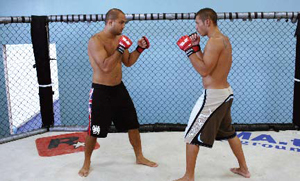
2. I turn my hips and shoulders in a counterclockwise direction, loading up for the left hook.
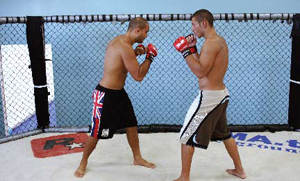
3. Turning my hips and shoulders in a clockwise direction, I throw the hook. Notice how my left arm is parallel to the ground and my right arm is up to protect my face. As my hook whips around, I carry my momentum slightly forward so I can drop in for the double leg takedown.
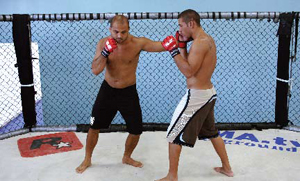
4. Dropping my level, I explode off my right leg and step my left foot between Paco’s legs. Notice how I keep my right hand up to protect my face from any strikes Paco may throw as I break the distance between us.

5. As I enter for the double, I wrap both arms around the back of Paco’s knees.
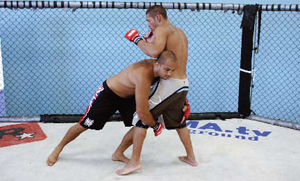
6. Using the momentum I generated off my initial explosion, I step forward with my right foot and continue to drive my weight into Paco. As I do this, I reestablish a sturdy base and realign my posture. This will allow me to cut the corner and take Paco down.
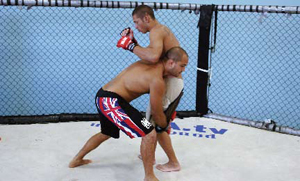
7. I step my left leg to the outside of Paco’s right leg, and then push off my right leg and drive my weight to my left. As I do this, I also drive my head into Paco’s ribs and pull his legs out to my right.
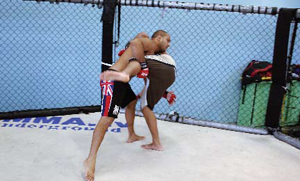
8. As I take Paco down, I clear his legs to avoid getting stuck in his guard. From here I will work to establish side control.
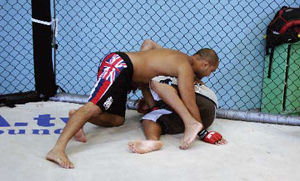
Cross to Takedown
I always prefer to shoot in off a left-handed strike because it sets up my hips, base, and balance in such a way that I can flow directly into the takedown. Executing a takedown off a right-handed strike such as the cross is a little more difficult because it disrupts your wrestling base, which is mandatory for a healthy shot. You can still shoot in off the cross, but you must reset your base before you do so. There are two ways to do this. The first is to throw the cross, pull your hand back into your stance, reset your hips, and then drop into a crouched stance and take your shot. The second way, which I show here, is to throw the cross and then step forward with your right foot. This allows you to reset your hips and assume the wrestling posture needed for the takedown. I’ve found that this way is more explosive and direct, but it can change the way you shoot in. If you take a long step forward, you will be in a southpaw stance. A lot of fighters who come from a wrestling background actually prefer this because they are accustomed to exploding forward off their right leg when it’s in front, but I like exploding forward off my right leg when it’s back. In order not to steer too far from the familiar, I will just take a small step with my right foot to cover some distance and realign my base. As long as I haven’t moved into a southpaw stance, I can still shoot in as I always do. It is important to learn both methods because you never know how your opponent will react to your assault. If you knock your opponent backwards with the cross, you might need to take a long step and shoot in from a southpaw stance in order to get the takedown. The more techniques you have tucked away in your arsenal, the better chance you’ll have at achieving your goal.
1. I’m in a standard fighting stance, squared off with Paco in the pocket.
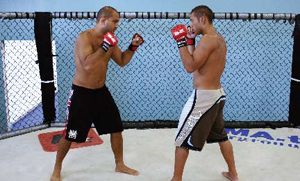
2. Whipping my hips in a counterclockwise direction, I throw a straight right cross to Paco’s chin.
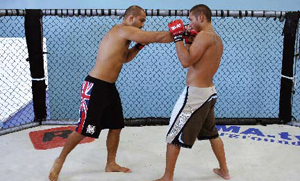
3. Rather than resetting my base off the cross, I take a small step forward with my right foot. This small step is essential because it not only allows me to continue with my forward momentum, but it also allows me to reset my base and penetrate with a balanced shot.
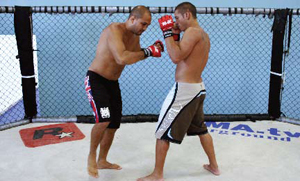
4. The instant my right foot hits the ground, I blast off my right leg and step my left foot between Paco’s legs. As I do this, I wrap both arms around the back of his knees. From here I will complete the double leg takedown—see previous technique.

This is an excerpt from Mixed Martial Arts: The Book of Knowledge by B.J. Penn, Glen Cordoza, and Erich Krauss. Victory Belt is the publisher. For more information about the book, see www.victorybelt.com.
Striking to the Takedown
Meshing strikes with takedowns is a fundamental component of MMA that far too many fighters neglect. I especially notice this with wrestlers and jiu-jitsu practitioners. The striking aspect of the sport often makes them nervous, so they attempt to shoot blindly in from outside of the pocket to avoid getting hit. As a result, their opponent defends their takedown attempts time and again and they end up getting hit a whole bunch. With the majority of MMA fighters possessing excellent takedown defense, you’ve got to learn how to move into the pocket with strikes and then transition to a takedown in order to be successful. If you move into the pocket without strikes, your opponent will see the takedown coming. If you shoot in from five feet away, he will also see the takedown coming. In this day and age, stealth is a must.
Don’t ever get locked into striking mode or takedown mode because your intent can be read from a mile away. There is no need to have two modes—they should be blended together to keep your opponent guessing. Once you learn which takedowns work off which strikes, the number of combinations you can string together become limitless. It’s good to find the ‘striking to takedown’ combinations that work best for you, but you should be proficient at shooting in off every punch you throw because you never know which punch in a combo will create an opening to take your opponent down. Having a large arsenal of combos will also prevent you from becoming a predictable fighter. If you only shoot in after throwing a hook, it won’t take long for your opponent to catch on. Every time you throw the hook, he will be prepared to defend the takedown.
Another good way to avoid telegraphing your takedowns is to vary the number of strikes you throw before shooting in. Sometimes it will pay to shoot in off a single punch, and other times you’ll want to shoot in after throwing three or four punches. But no matter what combo you utilize, it is important not to force the takedown. If you throw a combo and the opportunity to take your opponent down doesn’t present itself, step out of the pocket and set up your next combination. This will sometimes get your opponent thinking that you want to trade punches, which can take some of his focus away from defending the takedown.
I cannot stress enough the importance of blending the striking aspect of the sport with the grappling aspect. If you separate the two during training, you will have to switch modes during a fight. In the split second interim it takes you to switch modes, your opponent can prepare a defense or catch you off guard with a strike of his own. By endlessly practicing striking to takedown drills, you not only eliminate that mental shifting of gears, but you also condition your body to lash out with strikes one second and then change levels to shoot in for the takedown the next.
Hook to Takedown
This is by far my favorite ‘striking to takedown’ combination. The hook is a powerful strike that is hard to defend, but when you combine it with the double leg takedown, it creates a nearly unstoppable technique. When I say ‘combine,’ I mean just that. It’s not a left hook and then a double leg takedown, but rather a ‘left-hook/double.’ The entire technique is executed in one motion.
The combination is highly effective anytime during a fight. Sometimes your hook will land but your opponent manages to block the takedown, and other times your opponent will block the hook but you will get the takedown. It is very difficult for your opponent to block both, especially when you become a master at combining them into one motion. It is a perfect example of how the striking and grappling aspects of the game can be blended together to discombobulate your opponent and do some serious damage. Once you get this technique down, practice throwing two left hooks in a row and then shooting in for the takedown. The first hook is your power shot, and the second hook is more to set you up for the takedown. If you’re like me, you’ll find that it works unbelievably well.
1. I’m in a standard fighting stance, squared off with Paco in the pocket.

2. I turn my hips and shoulders in a counterclockwise direction, loading up for the left hook.

3. Turning my hips and shoulders in a clockwise direction, I throw the hook. Notice how my left arm is parallel to the ground and my right arm is up to protect my face. As my hook whips around, I carry my momentum slightly forward so I can drop in for the double leg takedown.

4. Dropping my level, I explode off my right leg and step my left foot between Paco’s legs. Notice how I keep my right hand up to protect my face from any strikes Paco may throw as I break the distance between us.

5. As I enter for the double, I wrap both arms around the back of Paco’s knees.

6. Using the momentum I generated off my initial explosion, I step forward with my right foot and continue to drive my weight into Paco. As I do this, I reestablish a sturdy base and realign my posture. This will allow me to cut the corner and take Paco down.

7. I step my left leg to the outside of Paco’s right leg, and then push off my right leg and drive my weight to my left. As I do this, I also drive my head into Paco’s ribs and pull his legs out to my right.

8. As I take Paco down, I clear his legs to avoid getting stuck in his guard. From here I will work to establish side control.

Cross to Takedown
I always prefer to shoot in off a left-handed strike because it sets up my hips, base, and balance in such a way that I can flow directly into the takedown. Executing a takedown off a right-handed strike such as the cross is a little more difficult because it disrupts your wrestling base, which is mandatory for a healthy shot. You can still shoot in off the cross, but you must reset your base before you do so. There are two ways to do this. The first is to throw the cross, pull your hand back into your stance, reset your hips, and then drop into a crouched stance and take your shot. The second way, which I show here, is to throw the cross and then step forward with your right foot. This allows you to reset your hips and assume the wrestling posture needed for the takedown. I’ve found that this way is more explosive and direct, but it can change the way you shoot in. If you take a long step forward, you will be in a southpaw stance. A lot of fighters who come from a wrestling background actually prefer this because they are accustomed to exploding forward off their right leg when it’s in front, but I like exploding forward off my right leg when it’s back. In order not to steer too far from the familiar, I will just take a small step with my right foot to cover some distance and realign my base. As long as I haven’t moved into a southpaw stance, I can still shoot in as I always do. It is important to learn both methods because you never know how your opponent will react to your assault. If you knock your opponent backwards with the cross, you might need to take a long step and shoot in from a southpaw stance in order to get the takedown. The more techniques you have tucked away in your arsenal, the better chance you’ll have at achieving your goal.
1. I’m in a standard fighting stance, squared off with Paco in the pocket.

2. Whipping my hips in a counterclockwise direction, I throw a straight right cross to Paco’s chin.

3. Rather than resetting my base off the cross, I take a small step forward with my right foot. This small step is essential because it not only allows me to continue with my forward momentum, but it also allows me to reset my base and penetrate with a balanced shot.

4. The instant my right foot hits the ground, I blast off my right leg and step my left foot between Paco’s legs. As I do this, I wrap both arms around the back of his knees. From here I will complete the double leg takedown—see previous technique.

|
B.J. ‘the prodigy’ Penn is highly regarded by many to be pound-for-pound the best mixed martial artist in the world. After earning his black belt in just four years and dominating Brazilian jiu-jitsu competition, he entered mixed martial arts and took the real fighting world by storm. Penn is currently coaching the next season of the UFC’s “Tough Enough” reality show on Spike T.V. In his new book Mixed Martial Arts: The Book of Knowledge, Penn shares the philosophy and intricate techniques that have allowed him to defeat UFC champions such as Matt Hughes. |
Search Articles
Article Categories
Sort by Author
Sort by Issue & Date
Article Categories
Sort by Author
Sort by Issue & Date

